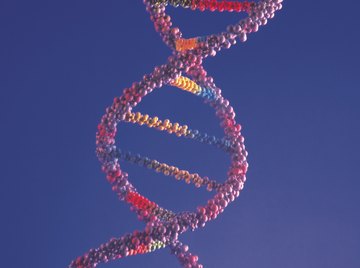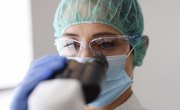
Deoxyribonucleic acid (DNA) contains all the codes necessary for life to continue. Within the rungs of the DNA molecule lies the instructions for cells to reproduce themselves and to reproduce the life form.
This tiny spiral-shaped ladder contains the codes of life within the pattern of the rungs.
Backbone of DNA Molecules
The first hints at the composition of DNA began in 1867 when Friedrich Miescher realized that, besides the protein he was looking for, cells also had a high phosphorus content and some substance that resisted protein digestion.
Later studies found that the sides of the DNA ladder are composed of what Miescher's work hinted at: phosphate and deoxyribose molecules. These phosphate and deoxyribose molecules form the backbone of DNA.
Continued studies of DNA eventually led to Crick and Watson's realization that the DNA molecule structure consists of a spiraling double helix. The phosphate and deoxyribose molecules form the sides of the DNA ladder while nitrogenous bases form the rungs.
Each set of one phosphate molecule, one deoxyribose molecule and one nitrogenous base form a nucleotide group.
Rungs of the DNA Molecule
In DNA, the "rungs" between the two strands of DNA are formed from the nitrogenous bases adenine, thymine, guanine and cytosine. In 1950, Erwin Chargaff published his discovery that the amount of adenine in DNA equals the amount of thymine and the amount of guanine in DNA equals the amount cytosine.
Each base pair contains one purine molecule and one pyrimidine molecule. Adenine and guanine are purine molecules while thymine and cytosine are pyrimidine molecules. The purine molecules have a double-ring nitrogenous structure while the pyrimidine molecules have a single-ring nitrogenous structure.
DNA Bonds
Adenine bonds with thymine and guanine bonds with cytosine. The molecules are joined together by hydrogen bonds. Adenine and thymine join with a double hydrogen bond while guanine and cytosine join with a triple hydrogen bond.
The differences between the molecular connections means that each nitrogenous base can only pair with the matching nitrogenous base. This is called the complementary base pairing rule.
The molecular structures of the nitrogenous bases ensure that the rungs of the DNA ladder are made of either an adenine-thymine pair or a guanine-cytosine pair. The rungs fit because the guanine-cytosine pair and the adenine-thymine rungs are the same length. The rungs can reverse direction (cytosine-guanine or thymine-adenine) but will not change connecting bases.
DNA Structure and Replication
Human DNA contains approximately 60 percent adenine-thymine pairs and about 40 percent guanine-cytosine pairs. About 3 billion base pairs form a strand of human DNA.
The arrangement of the nitrogenous base pairs and the hydrogen bonds between the pairs lets DNA molecules replicate in sections. The DNA essentially unzips along the hydrogen bonds in sections of 50 nucleotide groups at a time.
Complementary nitrogenous bases match up with the separated DNA sections. Since thymine bonds with adenine (and vice versa) while cytosine bonds with guanine (and vice versa), the DNA duplication proceeds with surprisingly few errors.
Mitosis and Meiosis
DNA structure and replication become important when cells divide. Mitosis happens when body cells divide. The section-by-section replication of the entire DNA strand provides a full strand of DNA for each of the resulting cells.
Errors in the DNA strand or strands form mutations. Many mutations are harmless, some may be beneficial and some may be harmful.
Meiosis occurs when special cells divide, then divide again to form egg or sperm (sex) cells that contain only half the normal DNA. Combining with a second sex cell yields the full strand of DNA required to develop a new and unique individual.
Mutations or mistakes in the dividing or matching process may or may not impact the developing organism.
Mutations
Some mutations occur when a mistake occurs during replication. Mutations include substitution, insertion, deletion and frameshift.
Substitution changes a nitrogenous base. Insertion adds one or more nitrogenous bases. Deletion removes one or more nitrogenous bases. Frameshift occurs when the sequence of bases shifts.
Since the sequence of bases controls the DNA instructions to the cell, frameshift can result in a change in the cell's behavior or construction.
References
- Nobelprize.org: The Discovery of the Molecular Structure of DNA - the Double Helix
- Education Portal: DNA-Adenine, Guanine, Cytosine, Thymine and Base Pairing
- ChemGuide: DNA - Structure
- Boise State University: The Structure of DNA
- University of Utah Learn.Genetics: Build a DNA Molecule
- NIH Genetics Home Reference: What is DNA?
- NIH Genetics Home Reference: How Do Cells Divide?
- DNA Worldwide: The History of DNA Timeline
About the Author
Karen earned her Bachelor of Science in geology. She worked as a geologist for ten years before returning to school to earn her multiple subject teaching credential. Karen taught middle school science for over two decades, earning her Master of Arts in Science Education (emphasis in 5-12 geosciences) along the way. Karen now designs and teaches science and STEAM classes.
Photo Credits
Comstock/Comstock/Getty Images
